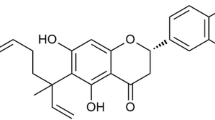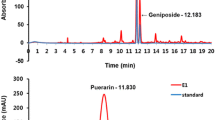Abstract
Schisantherin A, a dibenzocyclooctadiene lignan isolated from the fruit of Schisandra sphenanthera, has been used as an antitussive, tonic, and sedative agent under the name of Wuweizi in Chinese traditional medicine. In the present study, we carry out a screening program to identify the anti-inflammatory potentials of schisantherin A. We found that schisantherin A reduced lipopolysaccharide (LPS (1 mg/L))-induced levels of TNF-α, IL-6, NO, and PGE2 (p < 0.01 or p < 0.05), and also reduced levels of iNOS and COX-2 in RAW 264.7 macrophages in a concentration-dependent manner. We further investigated signal transduction mechanisms to determine how schisantherin A affects. RAW264.7 cells were pretreated with 0.5, 2.5, or 25 mg/L of schisantherin A 1 h prior to treatment with 1 mg/L of LPS. Thirty minutes later, cells were harvested and mitogen activated protein kinases (MAPKs) activation and IκBα was measured by Western blot. Alternatively, cells were fixed and nuclear factor-κB (NF-κB) activation was measured using immunocytochemical analysis. Signal transduction studies showed that schisantherin A significantly inhibited extracellular signal-regulated kinase (ERK), p38, and c-jun NH2-terminal kinase (JNK) phosphorylation protein expression. Schisantherin A also inhibited p65-NF-κB translocation into the nucleus by IκBα degradation. By using specific inhibitors of ERK, JNK and p38, we found that schisantherin A may inhibit TNF-α mostly through ERK pathway. Therefore, schisantherin A may inhibit LPS-induced production of inflammatory cytokines by blocking NF-κB and MAPKs signaling in RAW264.7 cells.









Similar content being viewed by others
References
Kubes, P., and D.M. Mccafferty. 2000. Nitric oxide and intestinal inflammation. American Journal of Medicine 109: 150–158.
Guha, M., and N. Mackman. 2001. LPS induction of gene expression in human monocytes. Cellular Signal 13: 85–94.
Vane, J.R., J.A. Mitchell, I. Appleton, A. Tomlinson, et al. 1994. Inducible isoforms of cyclooxygenase and nitric-oxide synthase in inflammation. PNAS 91: 2046–2050.
Chi, Y.S., H. Lim, H. Park, and H.P. Kim. 2003. Effects of wogonin, a plant flavone from Scutellaria radix, on skin inflammation: in vivo regulation of inflammation-associated gene expression. Biochemical Pharmacology 66: 1271–1278.
Barak, V., I. Kalickman, T. Halperin, S. Birkenfeld, and I. Ginsburg. 2004. PADMA-28, a Tibetan herbal preparation is an inhibitor of inflammatory cytokine production. European Cytokine Network 15: 203–209.
Genovese, M.C. 2005. Biologic therapies in clinical development for the treatment of rheumatoid arthritis. Journal of Clinical Rheumatology 11: S45–S54.
Li, R.T., W.S. Xiang, H. Li, Z.W. Lin, and H.D. Sun. 2004. Lancifodilactones B-E, new nortriterpenes from Schisandra lancifolia. Journal of Natural Products 67: 94–97.
Pu, J.X., W.L. Xiao, Y. Lu, R.T. Li, H.M. Li, L. Zhang, S.X. Huang, X. Li, Q.S. Zhao, Q.T. Zheng, and H.D. Sun. 2005. Kadlongilactones A and B, two novel triterpene dilactones from Kadsura longipedunculata possessing a unique skeleton. Organic Letters 7: 5079–5081.
Xiao, W.L., L.M. Yang, N.B. Gong, L. Wu, R.R. Wang, J.X. Pu, X.L. Li, S.X. Huang, Y.T. Zheng, R.T. Li, Y. Lu, and Q.T. Zheng. 2006. Rubriflordilactones A and B, two novel bisnortriterpenoids from Schisandra rubriflora and their biological activities. Organic Letters 8: 991–993.
Chen, Y.G., Y.Y. Xie, K.F. Cheng, K.K. Cheung, and G.W. Qin. 2001. Compounds from Kadsura ananosma. Phytochemistry 58: 1277–1280.
Opletal, L., H. Sovova, and M. Bartlova. 2004. Dibenzocyclooctadiene lignans of the genus Schisandra: importance, isolation and determination. Journal of Chromatography B 812: 357–361.
Ding, P.L., D.F. Chen, K.F. Bastow, et al. 2004. Cytotoxic isoprenylated flavonoids from the roots of sophora flavescens. Helvetica Chimica Acta 87: 2574–2580.
Kiso, Y., M. Tohkin, H. Hikino, Y. Ikeya, and H. Taguchi. 1985. Schisandra chinensis (Turcz.) Baill. Planta Medica 4: 331–334.
Guo, L.Y., T.M. Hung, K.H. Bae, et al. 2008. Anti-inflammatory effects of schisandrin isolated from the fruit of Schisandra chinensis Baill. European Journal of Pharmacology 591: 293–299.
Johnson, G.L., and R. Lapadat. 2002. Mitogen-activated protein kinase pathways mediated by ERK, JNK, and p38 protein kinases. Science 298: 1911–1912.
Kim, Y.H., S.H. Lee, J.Y. Lee, S.W. Choi, J.W. Park, and T.K. Kwon. 2004. Triptolideinhibits murine-inducible nitric oxide synthase expression by down-regulating lipopolysaccharide induced activity of nuclear factor-kappa B and c-Jun NH2-terminal kinase. European Journal of Pharmacology 494: 1–9.
Olsson, S., and R. Sundler. 2006. The role of lipid rafts in LPS-induced signaling in a macrophage cell line. Molecular Immunology 43: 607–612.
Li, Q., and I.M. Verma. 2002. NF-kappaB regulation in the immune system. Nature Reviews. Immunology 2: 725–734.
Bayon, Y., M.A. Ortiz, F.J. Lopez-Hernandez, F. Gao, M. Karin, M. Pfahl, and F.J. Piedrafita. 2003. Inhibition of IkappaB kinase by a new class of retinoid-related anticancer agents that induce apoptosis. Molecular and Cellular Biology 23: 1061–1074.
Takeda, K., T. Kaisho, and S. Akira. 2003. Toll-like receptors. Annual Review of Immunology 21: 335–376.
Towbin, H., T. Staehelin, and J. Gordon. 1992. Electrophoretic transfer of proteins from polyacrylamide gels to nitrocellulose sheets: procedure and some applications. Biotechnology 24: 145–149.
Aggarwal, B.B., and K. Natarajan. 1996. Tumor necrosis factors: developments during the last decade. European Cytokine Network 7: 93–124.
Kim, S.J., H.J. Jeong, P.D. Moon, K.M. Lee, H.B. Lee, H.J. Jung, and S.K. Jung. 2005. Anti-inflammatory activity of gumiganghwaltang through the inhibition of nuclear factor-kappa B activation in peritoneal macrophages. Biological and Pharmaceutical Bulletin 28: 233–237.
Martel, P.J., J.P. Pelletier, and H.S. Fahmi. 2003. Arthritis and Rheumatism 33: 155–167.
Huyke, C., K. Engel, K.W. Quirin, et al. 2007. Composition and biological activity of different extracts from Schisandra sphenanthera and Schisandra chinensis. Planta Medica 73: 1116–1126.
Sun, Y., Y.H. Li, Q. Xu, et al. 2006. Ethanol extract from Artemisia vestita, a traditional Tibetan medicine, exerts anti-sepsis action through down-regulating the MAPK and NF-κB pathways. International Journal of Molecular Medicine 17: 957–962.
Vandenberghe, W., S. Plaisance, E. Boone, K. Debosscher, M.L. Schmitz, W. Fiers, and G.J. Haegeman. 1998. Biological Chemistry 273: 3285–3290.
Hommes, D.W., and M.P. Peppelenbosch. 2003. Mitogen activated protein (MAP) kinase signal transduction pathways and novel anti-inflammatory targets. Gut 52: 144–151.
Anderson, K., and R. Sundler. 2000. Signaling to translational activation of tumour necrosis factor-α expression in human THP-1 cells. Cytokine 12: 1784–1787.
Chen, T.H., Y.C. Kao, B.C. Chen, C.H. Chen, P. Chan, and H.M. Lee. 2006. Dipyridamole activation of mitogen-activated protein kinase phosphatase-1 mediates inhibition of lipopolysaccharide-induced cyclooxygenase-2 expression in RAW 264.7 cells. European Journal of Pharmacology 541: 138–146.
Kim, B.C., J.W. Choi, H.Y. Hong, S.A. Lee, S. Hong, E.H. Park, S.J. Kim, and C.J. Lim. 2006. Heme oxygenase-1 mediates the anti-inflammatory effect of mushroom Phellinus linteus in LPS-stimulated RAW264.7 macrophages. Journal of Ethnopharmacology 106: 364–371.
Hyo, W.J., H.K. Young, C.B. Yong, and M.P. Kwon. 2007. Wen-Pi-Tang-Hab- Wu-Ling- San extract inhibits the release of inflammatory mediators from LPS-stimulated mouse macrophages. Journal of Ethnopharmacology 114: 439–445.
Baeuerle, P.A., and D. Baltimore. 1996. NF-kappa B: ten years after. Cell 87: 13–20.
Kim, J.B., A.R. Han, E.Y. Park, et al. 2007. Inhibition of LPS-induced iNOS, COX-2 and cytokines expression by Poncirin through the NF-κB inactivation in RAW 264.7 macrophage cells. Biological & Pharmaceutical Bulletin 30: 2345–2351.
Cohen, J. 2002. The immunopathogenesis of sepsis. Nature 420: 885–891.
Acknowledgments
This work was supported by a grant from the National Natural Science Foundation of China (No. 30671586).
Author information
Authors and Affiliations
Corresponding author
Rights and permissions
About this article
Cite this article
Ci, X., Ren, R., Xu, K. et al. Schisantherin A Exhibits Anti-inflammatory Properties by Down-Regulating NF-κB and MAPK Signaling Pathways in Lipopolysaccharide-Treated RAW 264.7 Cells. Inflammation 33, 126–136 (2010). https://doi.org/10.1007/s10753-009-9166-7
Published:
Issue Date:
DOI: https://doi.org/10.1007/s10753-009-9166-7




